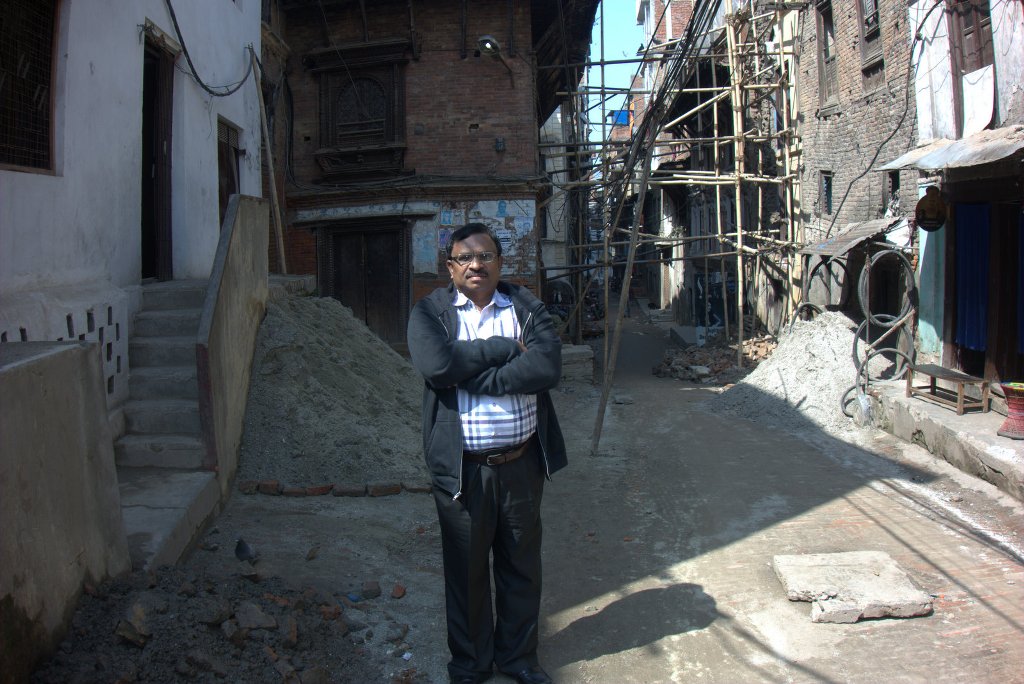
After a year-long waiting I made a visit to Nepal especially Kathmandu and Dhading District areas where I could reach. Many parts of the earthquake affected areas in remote villages are still difficult to reach smoothly, must walk through mountains many hours and people staying in temporarily shelters make shifts frequently. The massive 7.9 magnitude earthquake on April 25th of 2015 destroyed one of the world’s poorest nations, took the lives of many thousands and around one million people became homeless and jobless.
I visited Nepal from February 28 to March 7, 2016, and visited the earthquake affected places with the support of Mrs. Sushma Pant an ARI (Japan) graduate, Imam Nazrul Hussain Falahi, President of Islamic Sangh (Society) of Nepal and few occasions by myself alone. Sushma is a Hindu Brahmin (80% of Nepalese are Hindus) by birth and active in social services besides her job in a bank. Mr. Nazrul Hussain Falahi is a Muslim by faith and Islamic Sangh (society) represents all registered Muslim service organizations of Nepal (4.5 % of the 28 million populations). Muslims are the weaker section of the Nepal society.
I handed over our donation and told them that it was collected mainly from Japan and India (my friends who works abroad) to show our solidarity with the earthquake affected people of Nepal, as human beings. They were so happy to receive the donation and shared their love and gratitude in tears about the fondness we expressed, though many of us are not known each other. They have extended their gratitude and requested me to convey their thanks to all who support and pray for the people of Nepal. This time they have decided to make use our donation to support the school dropout children due to the harsh life after the earthquake.
I was invited to share about the recovery of Japan from Second World War and the massive earth quake of Sendai on 2011 to the students in Kathmandu where their public school almost got destroyed and now functioning under temporarily Tin Sheets roof building which was built with the support of our friends also. Due to the unexpected catastrophe in their childhood, students have a kind of stress about future, so I spent few hours with two divisions of students, class VIII and IX. The beginning was not easy however later they started to smile and sing songs and forced even me to sing.
Imam Nusrul and Mrs. Sushma have been working with me for long time as our Nepal interfaith leaders. They told me that the earth quake has made people more tolerant and learnt the space to live together. It was very heartbreaking to see the destructions of homes, small business shops, agriculture fields, World heritage sites etc. Still, nearly around one year, most of the areas did not rebuild. Now-a-days, electricity available only 11 hours a day, so in the midst of this cold season it has been too much suffering for the ordinary people. Gasoline prices are gone up and not able to get it without hours of "queue" in the gasoline stations. Petroleum coming from India to Nepal, a land locked country so the unrest in the border with India either stopped or slowed moving of gasoline transportation, which forced to shut down majority of the gasoline stations in Nepal.
From a tropical weather like Kerala, staying in a non a/c hotel even without a heater was very challenging for me but I overcame it.
Photos attached are the charity services of our friends’ organizations and some are the real faces of the catastrophe. The authorities assumed that there is a need for 10 year assistance from international community to recover from the destructions. My friends repeatedly requested for a three year support from SEEDS and I told them that I will try best to help them. Hope you will also think about it and join us in this humanitarian assistance to one of the world’s poorest nations.
Thanks for your prayers and cooperation.
Sincerely Yours,
Thomas Mathew
Director, SEEDS-India (seedsindia.net)
Click here to view more photos
PS.
Brief details of the Nepal Earthquake
A massive 7.9 magnitude earthquake hit Nepal with devastating force less than 50 miles from the capital, Kathmandu, causing tremors in northern India as well, on 25 April 2015. It killed more than 8,000 people in Nepal and some in neighbouring India and Tibet. 11 districts of Nepal, especially Sindhupalchok, Dhading and Gorkha, were the worst hit. The national crisis caused by the April 25 earthquake and its aftermath has pushed an estimated one million people below poverty line. As per the Human Development Report (2014), the poverty prevalence in Nepal is 23.8 percent. It means that around a quarter of the population in that year was living on less than $1.25 a day. But if the international poverty line of $1.25 a day was raised to $2 a day at that time, 57.3 per cent of the population would have been categorized as poor. The devastating quake and aftershocks damaged assets and properties valued at $5.13 billion. According to the PDNA (Post-Disaster Needs Assessment) report, of the people who fall back into poverty, roughly 50 to 70 percent are likely to hail from rural central hills and mountains where overall vulnerability was very high prior to the earthquake.
Kathmandu Durbar Square (Basantapur Darbar Kshetra) in front of the old royal palace of the former Kathmandu Kingdom is one of three Durbar (royal palace) Squares in the Kathmandu Valley in Nepal, all of which are UNESCO World Heritage Sites. As such, the square remains the traditional heart of the old town and Kathmandu’s most spectacular legacy of traditional architecture. The entire square was designated a UNESCO World Heritage Site in 1979. Unfortunately most parts of it destroyed by the earthquake.
The Pashupatinath Temple is a famous (UN Heritage site), sacred Hindu temple and the Buddhist temple complex at Swayambhunath, Kathmandu founded in the 5th Century, has also been damaged.
***